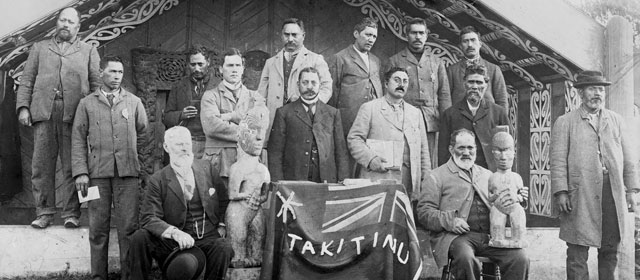Story summary
19th century
Māori society was traditionally based on whānau (family), hapū (sub-tribe) and iwi (tribe).
In 1835 a number of tribes grouped together to form the United Tribes of New Zealand – Te Wakaminenga o Nu Tirene. They signed a Declaration of Independence. This confederation was referred to in the Treaty of Waitangi.
As tribes came under pressure to sell land, and later were at war with the government over land, other political pan-tribal groups formed, including the Kīngitanga (the King Movement), and Te Kotahitanga (unity).
Pai Mārire, begun by the prophet Te Ua Haumēne, was the first of a number of religious movements which also had political influence.
20th century
Māori councils were formed by the government in 1900. Although they were tribally based, they were thought to be an attempt by government to control iwi.
Increasingly Māori land was managed by trusts and incorporations rather than by whānau or hapū.
The Young Māori Party was formed by former pupils of Te Aute College. They wanted tribes to undergo social and health reforms.
During the Second World War, tribes came together in the Māori War Effort Organisation. The 28th Māori Battalion was organised on a tribal basis.
After the war, many people moved from tribal areas to cities. The Māori Women’s Welfare League was formed in 1951. Its members helped people adjust to life in the cities.
The New Zealand Māori Council, established in 1962, took some landmark cases to court about Māori rights under the Treaty of Waitangi.
Protest organisations
From the 1970s groups formed to protest for Māori rights. They included Ngā Tamatoa and Te Reo Māori Society. In 1975 Te Rōpū Matakite o Aotearoa led a march on Parliament to protest about the loss of Māori land – 40,000 people participated.
The Ōrākei Māori Action Group occupied land at Takaparawhā (Bastion Point) in Auckland to protest against a proposed sale. After 506 days they were removed by police and the army.
A number of pan-tribal groups came together to protest at Waitangi from 1984.
Māori education
The Maori Education Foundation was formed in 1961 to promote education at secondary and tertiary level.
Protests about te reo Māori (Māori language) led to the formation of kōhanga reo (Māori-language pre-schools) and kura (schools). Later three wānanga (universities) were established.
Other groups
Te Puna Waihanga was one of a number of groups which fostered Māori art – traditional arts like weaving, as well as contemporary art.
People in cities formed urban marae. Some of these were pan-tribal. People from different tribes also came together through sports groups.
Māori nurses sought reforms in health through the Māori Nurses’ Organisation.
In 1975 the Waitangi Tribunal was established to investigate breaches of the Treaty of Waitangi. Te Taura Whiri i te Reo Māori was established after people took a claim to the tribunal about the Māori language. Other claims led to the establishment of Māori radio stations and Māori television. Claims about fisheries and forests led to large settlements. Tribal settlements have led to the establishment of sizeable Māori businesses.
A number of Māori urban authorities were established and began to play a role in education, health, employment training and other social services.





